How To Get Bigger Legs At Home
Many guys will do anything to weasel their way out of a big legs workout , but here you are.
And for that, I commend you.
The fact that you want to learn how to get bigger legs means you've probably sloughed off the mistaken idea that a great physique is all about big arms, a square chest, and capped shoulders.
These things are nice, of course, but if you don't have big enough thighs to balance things out, your physique can look lopsided and cartoonish.
In this article, you're going to learn everything you need to know about how to get bigger thighs . You'll learn the best bigger thighs workout for building thigh mass, how to gain weight in your legs using some simple diet strategies, and my top three tips for how to get thicker legs .
- Barbell Leg Workout
- Barbell Back Squat
- Barbell Front Squat
- Romanian Deadlift
- Lying Leg Curl
- Dumbbell Leg Workout
- Dumbbell Bulgarian Split Squat
- Dumbbell Romanian Deadlift
- Dumbbell Lunge
- Dumbbell Goblet Squat
- Bodyweight Leg Workout
- Bodyweight Bulgarian Split Squat
- Bodyweight Single-Leg Romanian Deadlift
- Bodyweight Step-up
- Bodyweight Glute Bridge
- Diet for Bigger Legs
- Eat enough calories.
- Eat a lot of protein and carbs.
- Take the right supplements.
- My Top 3 Tips for Getting Bigger Legs
- 1. Prioritize the right compound exercises in your workouts.
- 2. Try to add weight or reps to every exercise in every workout.
- 3. Rest at least 2 to 3 minutes between sets.
- 4. Train your thighs with 10-to-20 sets per week.
Table of Contents
Barbell Leg Workout
Barbell Back Squat
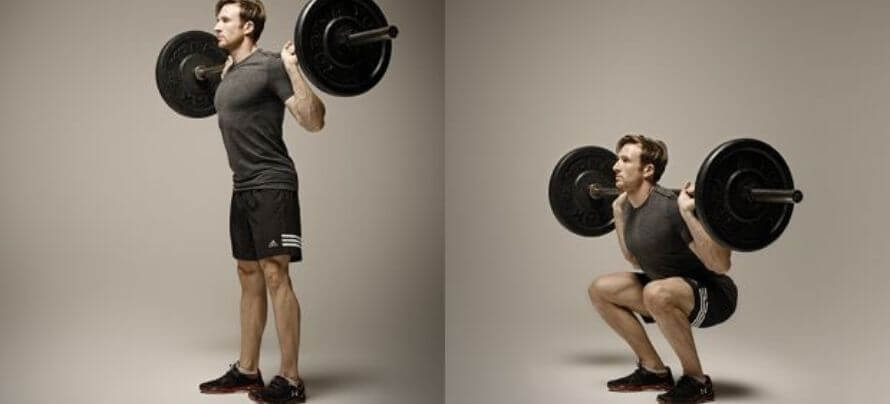
Sets: 3 | Reps: 4 to 6 | Rest: 2 to 3 min
Position a barbell in a squat rack at about the height of your breast bone. Step under the bar, pinch your shoulder blades together, and rest the bar directly above the bony ridges on the bottom of your shoulder blades. Lift the bar out of the rack, take one or two steps backward, and place your feet a little wider than shoulder-width apart with your toes pointing slightly outward. Sit down and remember to keep your back straight and push your knees out in the same direction as your toes throughout each rep, then stand up to return to the starting position.
Barbell Front Squat
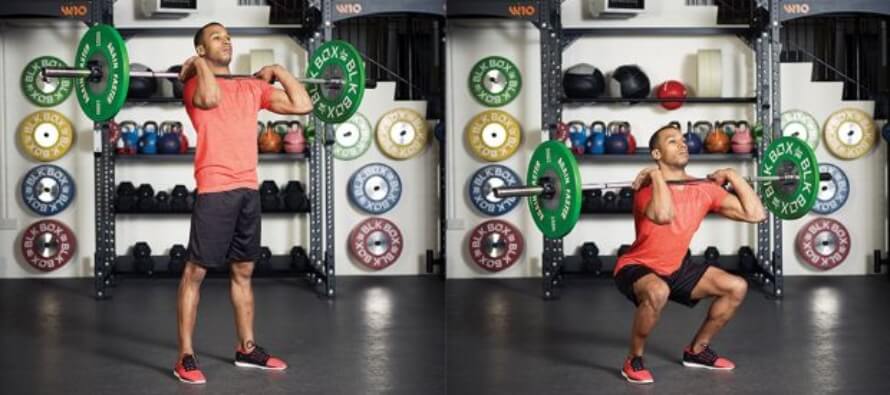
Sets: 3 | Reps: 4 to 6 | Rest: 2 to 3 min
Position a barbell in a squat rack at about the height of your breast bone. Grab the bar with a shoulder-width grip and your palms facing away from you. Step closer to the bar so that it presses against the top of your breast bone and push your elbows up and out in front of the bar. With the bar resting on the front of your shoulders and held in place by your hands, lift it out of the rack, take one or two steps backward, and place your feet a little wider than shoulder-width apart with your toes pointing slightly outward. Sit down and remember to keep your back straight, elbows up, and push your knees out in the same direction as your toes throughout each rep. Stand up and return to the starting position.
Romanian Deadlift
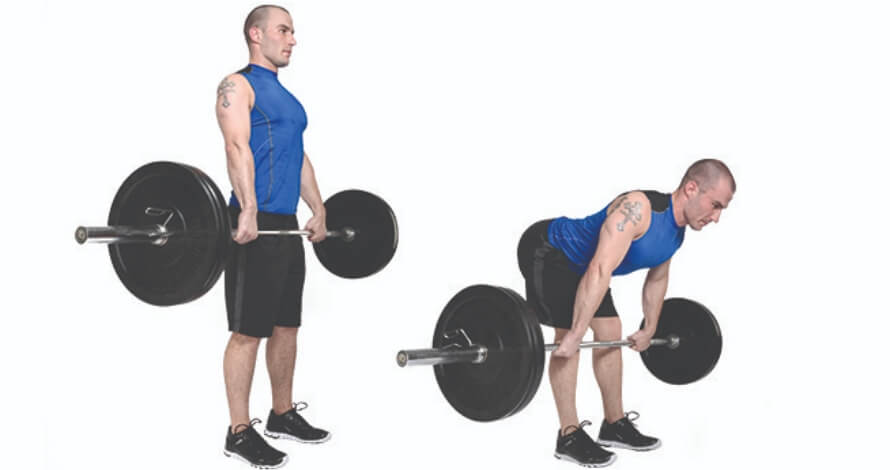
Sets: 3 | Reps: 8 to 10 | Rest: 2 to 3 min
Stand up straight holding a loaded barbell with a shoulder-width grip and your hands facing toward you. Flatten your back and lower the weights toward the floor in a straight line while keeping your legs mostly straight, allowing your butt to move backward as you descend.
Once you feel a stretch in your hamstrings, bend your knees slightly more, and continue lowering the weights until your lower back begins to round—just below the knees for most people, and about mid-shin for those who are particularly flexible. Reverse the movement and return to the starting position.
Lying Leg Curl
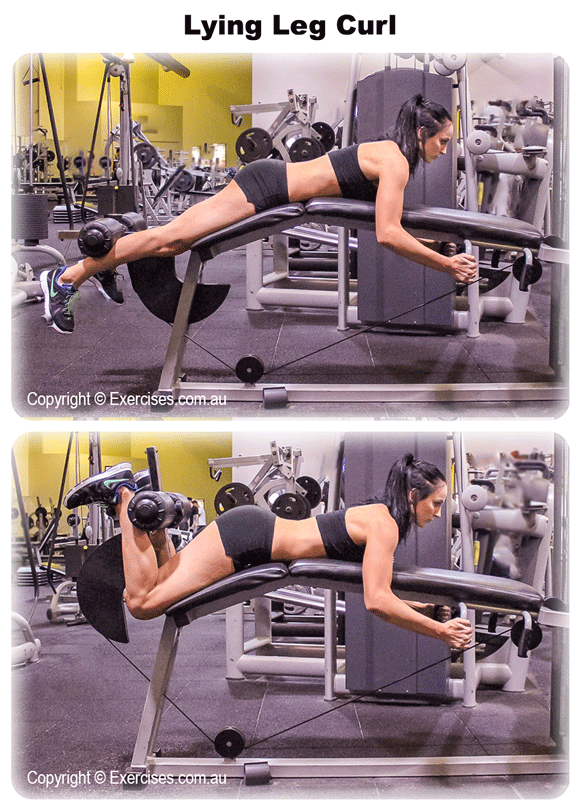
Sets : 3 | Reps : 8 to 10 | Rest : 2-to-3 min
Adjust the leg pad so that it rests against your mid calf when you lie on the machine. Lie face down and grab the handles, then curl the pad toward your butt by pushing against the leg pad. Reverse the movement and return to the starting position.


Dumbbell Leg Workout
Dumbbell Bulgarian Split Squat
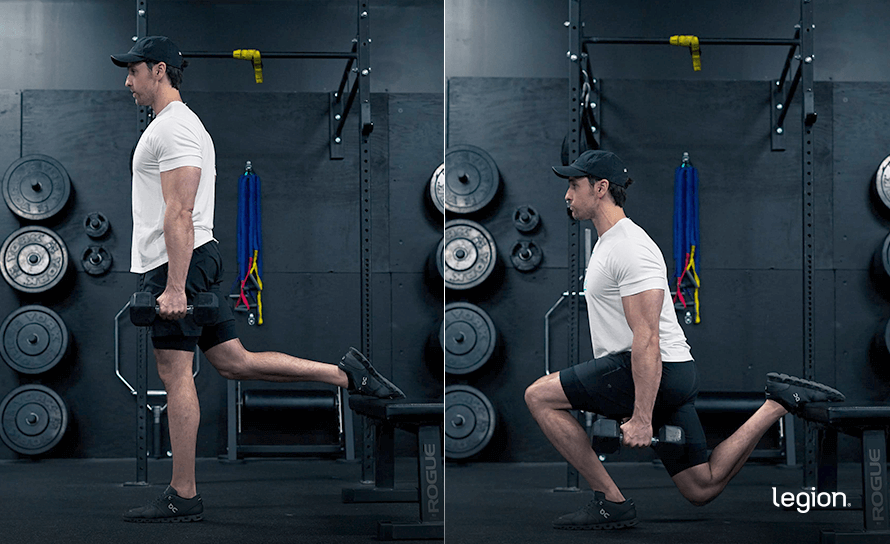
Sets: 3 | Reps: 8 to 12 | Rest: 2 to 3 min
While holding a dumbbell in each hand, stand about two-to-three feet in front of a bench. With your right foot (and heel in particular) firmly planted, place the top of your left foot on the bench behind you. Look at a spot on the floor six-to-ten feet in front of you and lower your butt toward the floor by bending at your right knee. Keep lowering yourself until your right thigh is roughly parallel with the floor. Stand up and return to the starting position.
Dumbbell Romanian Deadlift
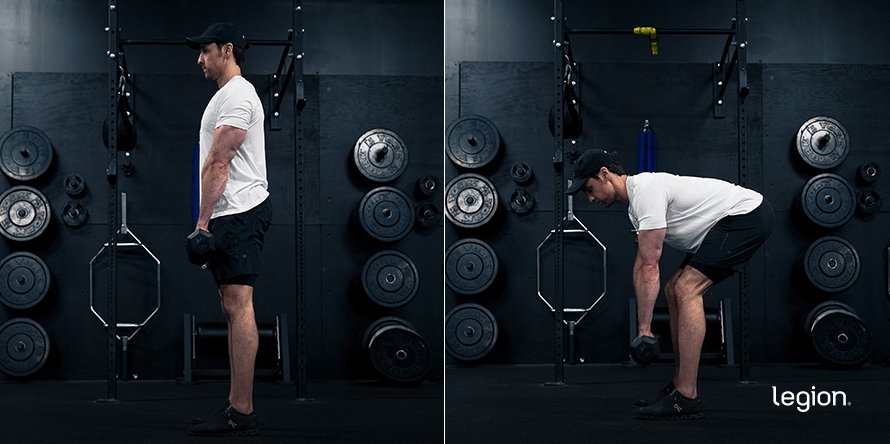
Sets: 3 | Reps: 4 to 6 | Rest: 2 to 3 minutes
Hold a dumbbell in each hand. With a flat back (no rounding!), lower the weights toward the floor in a straight line, allowing your butt to move backward as you descend. Once you feel a stretch in your hamstrings, bend your knees slightly more, and continue lowering the weights until your lower back begins to round—just below the knees for most people, and about mid-shin for those who are particularly flexible. Then return to the starting position.
Dumbbell Lunge
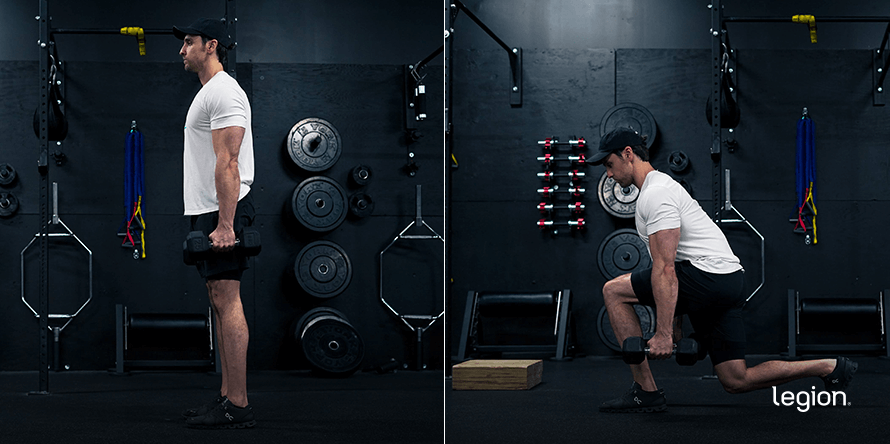
Sets: 3 | Reps: 8 to 10 | Rest: 2 to 3 minutes
Holding a dumbbell in each hand, stand up straight with both feet about shoulder-width apart. Take a long step forward with your right foot—about two-to-three feet. With most of your weight on your front foot, kneel down until your left knee touches the floor. Then, reverse the motion by pushing off the floor with your front foot and leaning slightly backward, allowing your legs to straighten. Once you're standing, bring your right foot back to the starting position.
Dumbbell Goblet Squat
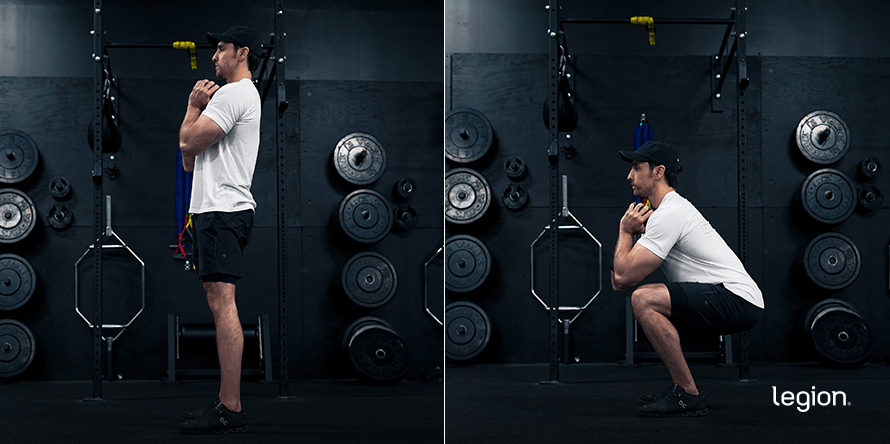
Sets: 3 | Reps: 10 to 20 | Rest: 2 to 3 min
Stand up straight with your feet slightly wider than shoulder-width apart with your toes turned slightly out, and hold a dumbbell vertically against your chest. While keeping your back straight, squat down until your thighs are parallel with the floor. Stand up and return to the starting position. Remember to push your knees out in the same direction as your toes throughout each rep.
Bodyweight Leg Workout
Bodyweight Bulgarian Split Squat
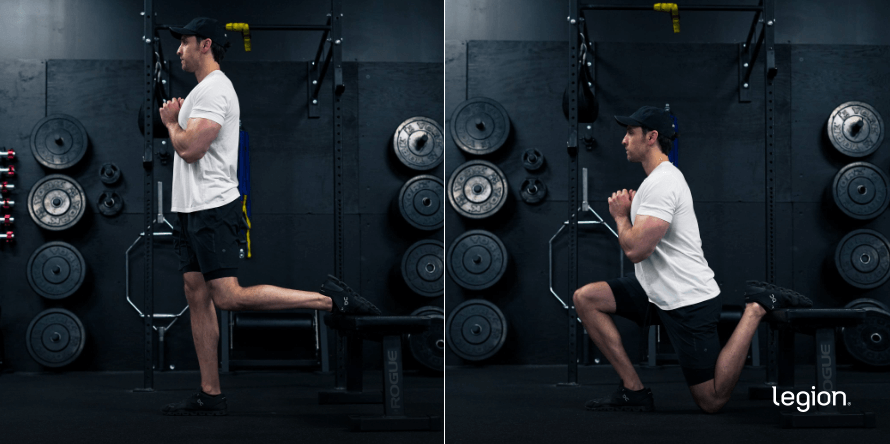
Sets: 3 | Reps: 10 to 20 | Rest: 2 to 3 minutes
Stand about two to three feet in front of a bench, couch, or set of stairs. With your right foot (and heel in particular) firmly planted, place the top of your left foot on the surface behind you. Look at a spot on the floor six-to-ten feet in front of you, and lower your butt toward the floor by bending at your right knee. Keep lowering yourself until your right thigh is roughly parallel with the floor. Then, stand up and return to the starting position.
Bodyweight Single-Leg Romanian Deadlift
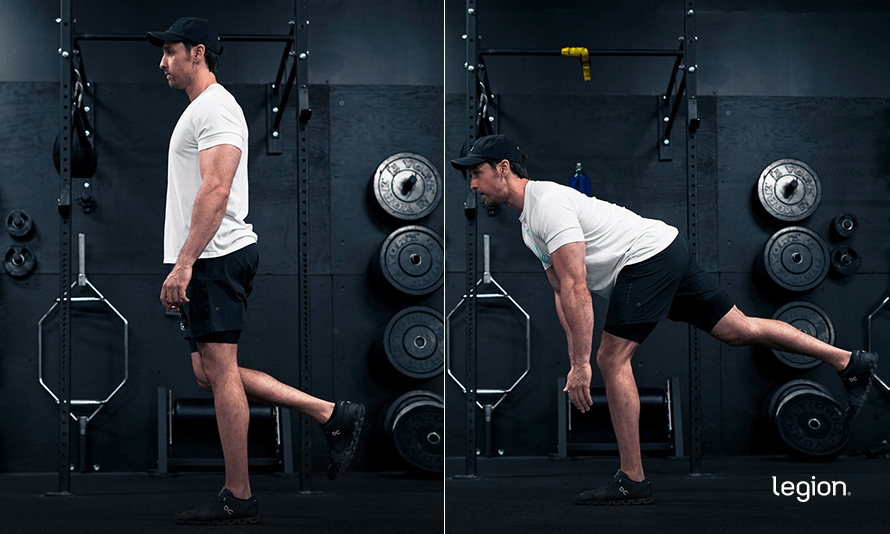
Sets: 3 | Reps: 10 to 20 | Rest: 2 to 3 minutes
Stand up straight and put your weight into your right leg (it may help to lift your left leg off the floor a few inches). Keeping a slight bend in your right knee, lean forward, extending your left leg behind you and bringing your chest closer to the floor. Once you start to feel a stretch in your hamstrings and your back is almost parallel with the floor, contract your glutes and return to the starting position.
Bodyweight Step-up

Sets: 3 | Reps: 10 to 20 | Rest: 2 to 3 minutes
Place your right foot on a box, bench, or other surface about knee-height off the floor. Keeping your weight on your right foot, fully straighten your right leg. Then, lower your left foot toward the floor, and return to the starting position.
Bodyweight Glute Bridge
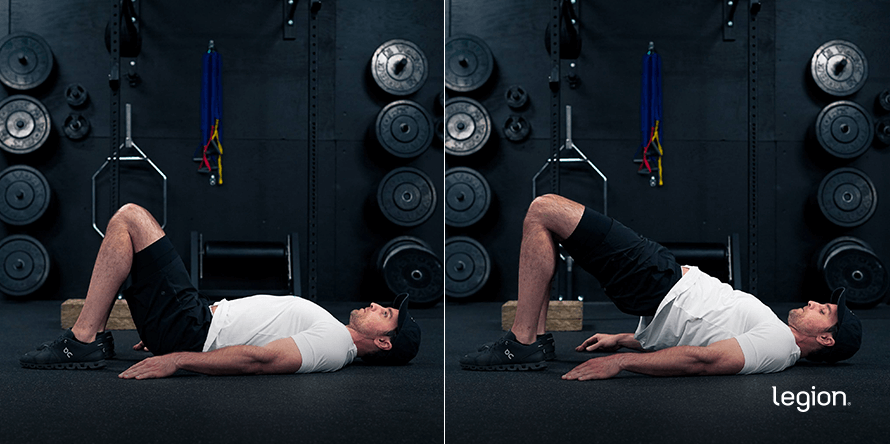
Sets: 3 | Reps: 10 to 20 | Rest: 2 to 3 minutes
Lie on your back on the floor and place your heels about a foot from your butt. Lift your butt off the floor by pressing your shoulders and heels into the floor. Raise your butt and squeeze your glutes until your butt, hips, and knees form a straight line, and then lower your butt back to the starting position.
Diet for Bigger Legs
Eat enough calories.
If you want to get thicker legs , you need to maintain a mild calorie surplus.
That is, you need to eat about 110% of your total daily energy expenditure (TDEE) every day. The reason for this is a calorie surplus optimizes your body's "muscle-building machinery," so to speak, greatly enhancing your body's ability to recover from and positively adapt to your training.
If you want to know more about how many calories you need to eat to build bigger legs (or any other muscle group), check out this article:
Bulking Guide: How to Gain Weight & Muscle without Gaining Fat
Eat a lot of protein and carbs.
In addition to eating the right number of calories, it's also important that you eat enough protein and carbs to build muscle and fuel your workouts. This is particularly true when you're trying to get bigger legs , as lower-body workouts burn up a lot of calories.
Here's how.
Protein: Eat 0.8-to-1 gram of protein per pound of body weight per day. This is enough to maximize muscle growth—eating more than this won't help you bulk up faster. This usually works out to around 20-to-40% of calories for most people.
Carbs: Eat at least 2-to-3 grams of carbs per pound of body weight per day. The reason you want to follow a high-carb diet while lean bulking is that this keeps your glycogen levels topped off, which improves your performance in the gym and positively impacts genes related to muscle growth. This usually works out to around 40-to-60% of calories for most people.
Generally, the best way to set up a lean bulking diet is eat about 1 gram of protein per pound of body weight per day, set your fat intake at about 20% of calories, and fill in the rest with carbs.
Take the right supplements.
I saved this for last because it's the least important.
Unfortunately, no amount of pills and powders are going to automagically give you bigger legs. In fact, most muscle-building supplements are completely worthless .
But here's the good news:
If you know how to eat and train to build muscle—following the steps we just covered—certain supplements can help you get bigger thighs faster . (And if you'd like to know exactly what supplements to take to reach your fitness goals, take the Legion Supplement Finder Quiz.)
Here are the best supplements for getting thicker legs as fast as possible:
- 0.8-to-1 gram of protein per pound of body weight per day. This provides your body with the "building blocks" it needs to build and repair muscle tissue and help you recover from your workouts. If you want a clean, convenient, and delicious source of protein, try Whey+ or Casein+ .
- 3-to-5 grams of creatine per day. This will boost muscle and strength gain, improve anaerobic endurance, and reduce muscle damage and soreness from your big legs workouts . If you want a 100% natural source of creatine that also includes two other ingredients that will help boost muscle growth and recovery, try Recharge .
- One serving of Pulse per day. Pulse is a 100% natural pre-workout drink that enhances energy, mood, and focus; increases strength and endurance; and reduces fatigue. You can also get Pulse with caffeine or without .
My Top 3 Tips for Getting Bigger Legs
1. Prioritize the right compound exercises in your workouts.
A compound exercise is any type of exercise that trains several major muscle groups at the same time like the squat , deadlift , and bench and overhead press .
Research shows that if you want to build as much muscle as possible, nothing beats compound weightlifting.
Exercises that involve just one joint and major muscle group at a time—also known as isolation exercises —can still have a place in your program, but if building muscle is your main goal, you should put most of your energy into compound exercises.
That said, not all compound exercises were created equal.
In your big leg workouts you want to focus on effective compound leg exercises like the squat, Romanian deadlift , and lunge, and you want to avoid wasting your time on ineffective compound leg exercises including anything that involves the Smith machine.
This is because research shows that exercises done using a Smith machine produce smaller gains in muscle and strength than free weights. The main reason for this is the machine's bar travels on a fixed, vertical path. This makes it easier to move than a barbell, which can move in all directions (forcing you to keep it stable).
2. Try to add weight or reps to every exercise in every workout.
If you stop getting stronger, your legs will eventually stop getting bigger (this applies to every major muscle group in the body, by the way).
The best way to get strong is to ditch the high-rep "pump" training and lift heavy.
By "heavy," I mean doing the majority of your leg exercises with weights in the range of 75-to-85% of your one-rep max (1RM), or in the range of 8-to-10 (~75%) to 4-to-6 (~85%) reps.
But that's not all—you should also strive to add weight or reps to every exercise in every workout. This is known as progressive overload , and it's one of the best ways to maximize the muscle-building effects of weightlifting.
If you want to know more about how to get strong fast, check out this article:
The Definitive Guide to Strength Training: How to Get Strong…Fast
3. Rest at least 2 to 3 minutes between sets.
In most cases, this should give your muscles enough time to fully recoup their strength so you can give your maximum effort in each set.
That said, if you're feeling gassed between heavy sets of big, compound exercises like the squat or leg press, it's probably best to take a little longer—anywhere from 3-to-5 minutes should do the trick.
If you want to learn more about how long you should rest between sets, check out this article:
How Long Should You Rest Between Sets to Gain Muscle and Strength?
4. Train your thighs with 10-to-20 sets per week.
If you want to develop any major muscle group , including your legs, it's normally best to train it with a total of 10-to-20 weekly sets.
People who've been following a proper strength training program for less than two years should aim for 10-to-15 weekly sets (like the workouts included in this article), whereas those who've been training properly for more than two years should aim for 15-to-20 weekly sets.
Doing 10-to-15 sets in a single workout should be tough, but not too tough.
If you're doing upward of 15 weekly sets, though, you'll probably find that the quality of your sets begins to suffer as you get deeper into your workout. This is why it's normally better for more advanced weightlifters to divide their weekly sets over two or even three workouts per week.
If you want to know more about how much and how often you should train, check out this article:
The Best Training Frequency for Building Muscle (According to 20 Studies)
+ Scientific References
- Schoenfeld, B. J., Pope, Z. K., Benik, F. M., Hester, G. M., Sellers, J., Nooner, J. L., Schnaiter, J. A., Bond-Williams, K. E., Carter, A. S., Ross, C. L., Just, B. L., Henselmans, M., & Krieger, J. W. (2016). Longer interset rest periods enhance muscle strength and hypertrophy in resistance-trained men. Journal of Strength and Conditioning Research, 30(7), 1805–1812. https://doi.org/10.1519/JSC.0000000000001272
- Schick, E. E., Coburn, J. W., Brown, L. E., Judelson, D. A., Khamoui, A. V., Tran, T. T., & Uribe, B. P. (2010). A comparison of muscle activation between a Smith machine and free weight bench press. Journal of Strength and Conditioning Research, 24(3), 779–784. https://doi.org/10.1519/JSC.0b013e3181cc2237
- Schwanbeck, S., Chilibeck, P. D., & Binsted, G. (2009). A comparison of free weight squat to Smith machine squat using electromyography. Journal of Strength and Conditioning Research / National Strength & Conditioning Association, 23(9), 2588–2591. https://doi.org/10.1519/JSC.0b013e3181b1b181
- Gentil, P., Soares, S., & Bottaro, M. (2015). Single vs. Multi-joint resistance exercises: Effects on muscle strength and hypertrophy. Asian Journal of Sports Medicine, 6(2), 1–5. https://doi.org/10.5812/asjsm.24057
- Stokes, T., Hector, A. J., Morton, R. W., McGlory, C., & Phillips, S. M. (2018). Recent perspectives regarding the role of dietary protein for the promotion of muscle hypertrophy with resistance exercise training. In Nutrients (Vol. 10, Issue 2). MDPI AG. https://doi.org/10.3390/nu10020180
- Creer, A., Gallagher, P., Slivka, D., Jemiolo, B., Fink, W., & Trappe, S. (2005). Influence of muscle glycogen availability on ERK1/2 and Akt signaling after resistance exercise in human skeletal muscle. Journal of Applied Physiology, 99(3), 950–956. https://doi.org/10.1152/japplphysiol.00110.2005
- Howarth, K. R., Phillips, S. M., MacDonald, M. J., Richards, D., Moreau, N. A., & Gibala, M. J. (2010). Effect of glycogen availability on human skeletal muscle protein turnover during exercise and recovery. Journal of Applied Physiology, 109(2), 431–438. https://doi.org/10.1152/japplphysiol.00108.2009
- Helms, E. R., Aragon, A. A., & Fitschen, P. J. (2014). Evidence-based recommendations for natural bodybuilding contest preparation: Nutrition and supplementation. In Journal of the International Society of Sports Nutrition (Vol. 11, Issue 1, p. 20). BioMed Central Ltd. https://doi.org/10.1186/1550-2783-11-20
Readers' Ratings
4.6/5 (10)
Your Rating?
How To Get Bigger Legs At Home
Source: https://legionathletics.com/how-to-get-bigger-legs/
Posted by: carlsonyebbeet79.blogspot.com

0 Response to "How To Get Bigger Legs At Home"
Post a Comment